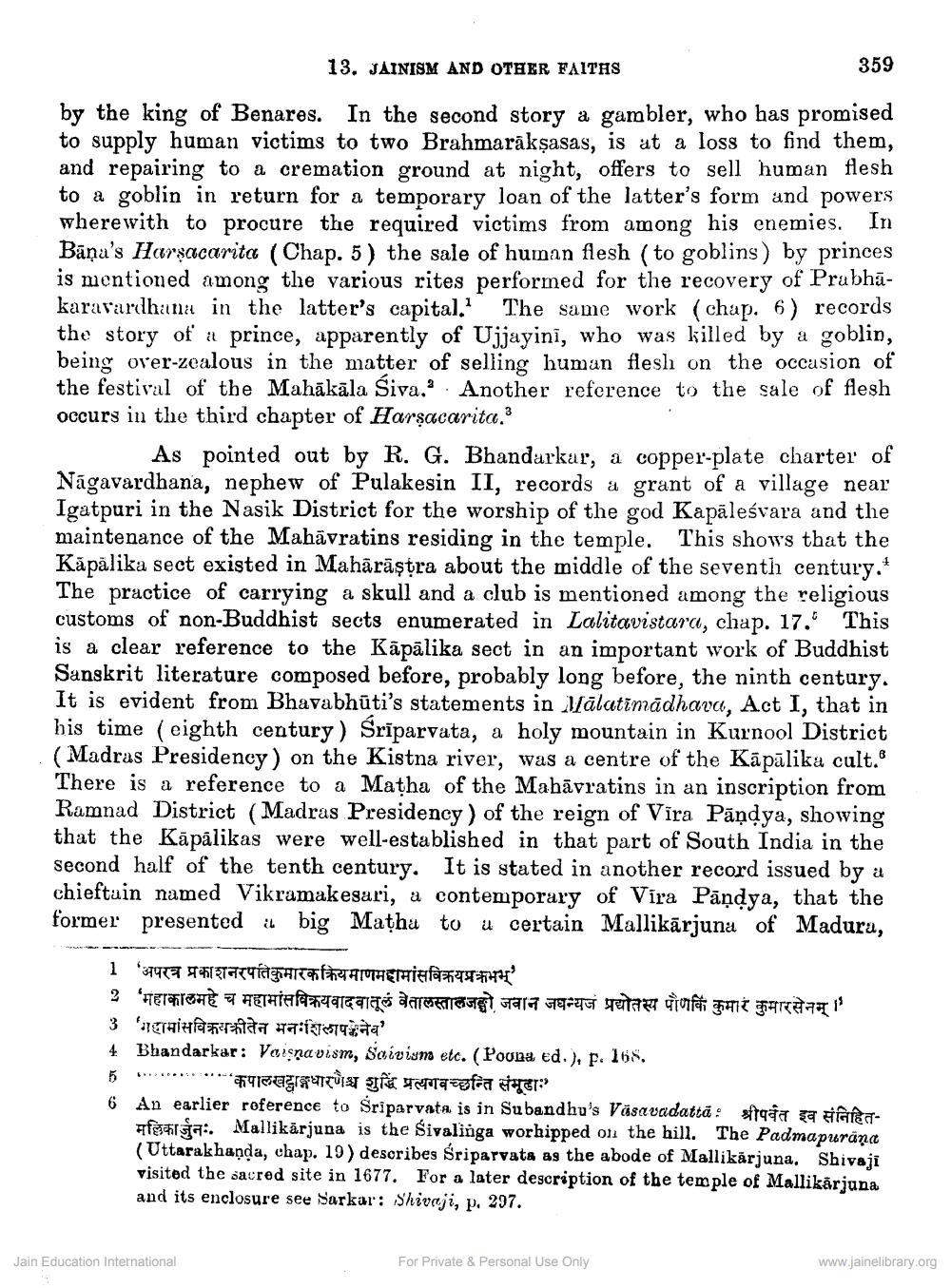________________
13. JAINISM AND OTHER FAITHS
359
by the king of Benares. In the second story a gambler, who has promised to supply human victims to two Brahmaraksasas, is at a loss to find them, and repairing to a cremation ground at night, offers to sell human flesh to a goblin in return for a temporary loan of the latter's form and powers wherewith to procure the required victims from among his enemies. In Bāņa's Harşacarita (Chap. 5) the sale of human flesh (to goblins) by princes
among the various rites performed for the recovery of Prabhākaravardhana in the latter's capital. The same work (chap. 6) records the story of a prince, apparently of Ujjayini, who was killed by a goblin, being over-zealous in the matter of selling human flesh on the occasion of the festival of the Mahākāla Siva," . Another reference to the sale of flesh occurs in the third chapter of Harsacarit
As pointed out by R. G. Bhandarkar, a copper-plate charter of Nāgavardhana, nephew of Pulakesin II, records a grant of a village near Igatpuri in the Nasik District for the worship of the god Kapāleśvara and the maintenance of the Mahāvratins residing in the temple. This shows that the Kāpälika sect existed in Mahārāştra about the middle of the seventh century.* The practice of carrying a skull and a club is mentioned among the religious customs of non-Buddhist sects enumerated in Lalitavistara, chap. 17. This is a clear reference to the Kāpālika sect in an important work of Buddhist Sanskrit literature composed before, probably long before, the ninth century. It is evident from Bhavabhūti's statements in Vālutinādhava, Act I, that in his time (eighth century) Śrīparvata, a holy mountain in Kurnool District (Madras Presidency on the Kistna river, was a centre of the Kāpālika cult. There is a reference to a Matha of the Mabāvratins in an inscription from Ramnad District (Madras Presidency) of the reign of Vira Pandva. that the Kāpālikas were well-established in that part of South India in the second half of the tenth century. It is stated in another record issued by a chieftain named Vikramakesari, a contemporary of Vira Pāņdya, that the former presented it big Matha to a certain Mallikārjuna of Madura,
1 'अपरत्र प्रकाशनरपतिकुमारकक्रियमाणमहामांसविक्रयप्रक्रम ३ 'महाकालमहे च महामांसविक्रयवादवातूल वेतालस्तालजडो जवान जघन्यज प्रद्योतस्य पौणकि कुमार कुमारसेनम् । 3 'गहामांसविक्रयक्रीतेन मन:शिलापटनेव' 4 Bhandarkar: Vaisnavism, Saivism etc. (Poona ed.), p. 168. 5 "...
aguTÙ2) fa Tarragfa er: 6 An earlier roference to Sriparvata is in Subandhu's Väsavadatta: sfoga za Gear
afshiga: Mallikarjuna is the Sivalinga worhipped on the hill. The Padmapurāņa (Uttarakhanda, chap. 19) describes Śriparvata as the abode of Mallikarjuna, Shivaji visited the sacred site in 1677. For a later description of the temple of Mallikarjuna and its enclosure see Sarkar: Shivaji, p. 297.
Jain Education International
For Private & Personal Use Only
www.jainelibrary.org




